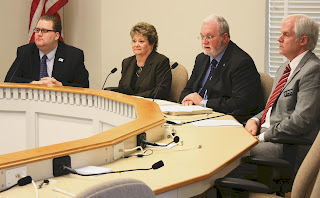 The Legislature’s first biennial budget proposal of the session came out today as House leaders rolled out the $8.9 billion transportation budget. The two-year plan will better connect Washington, generate construction jobs, and promote commerce, say House transportation leaders. Rep. Judy Clibborn, chair of the Transportation Committee, met with reporters at noon along with Rep. Marko Liias, vice-chair, Rep. Mike Armstrong, ranking member, and Rep. Mark Hargrove, assistant ranking member.
The Legislature’s first biennial budget proposal of the session came out today as House leaders rolled out the $8.9 billion transportation budget. The two-year plan will better connect Washington, generate construction jobs, and promote commerce, say House transportation leaders. Rep. Judy Clibborn, chair of the Transportation Committee, met with reporters at noon along with Rep. Marko Liias, vice-chair, Rep. Mike Armstrong, ranking member, and Rep. Mark Hargrove, assistant ranking member.The budget is expected to create or sustain about 43,000 jobs, which will help construction workers and their families, many of whom have been hit hard by the recession’s construction slump. The budget also maintains the momentum of existing projects across Washington, including the 2003 “Nickel” and 2005 Transportation Partnership Program packages, of which nearly 300 projects are already completed. About $3.9 billion is provided to continue remaining projects in the next biennium.
“Maintaining and expanding our infrastructure is essential to our economic recovery,” says Clibborn. “With this budget, we’re keeping our commitment to connecting the state. We want to minimize disruption and promote efficient travel so commuters can get to work and freight can reach its destinations.”
Looking ahead, long-term revenue forecasts are showing a decline in fuel-tax receipts as people use more fuel-efficient or alternative-power cars. That’s great news for the environment but a challenge for the transportation budget, which relies heavily on fuel taxes. So lawmakers have introduced some efficiency measures in the budget, including reducing operational expenses by $29.5 million and salary reductions to save $18 million. A tentative labor agreement between the state and ferry workers is expected to save an additional $20.5 million.
Even with the belt-tightening, most money in the budget is already dedicated to existing projects, leaving little for new projects. Clibborn says this points to the need for a statewide discussion about whether there’s interest for new revenue to fund a new round of projects.
The budget itself is available here, including an easy-to-read summary at the beginning.

